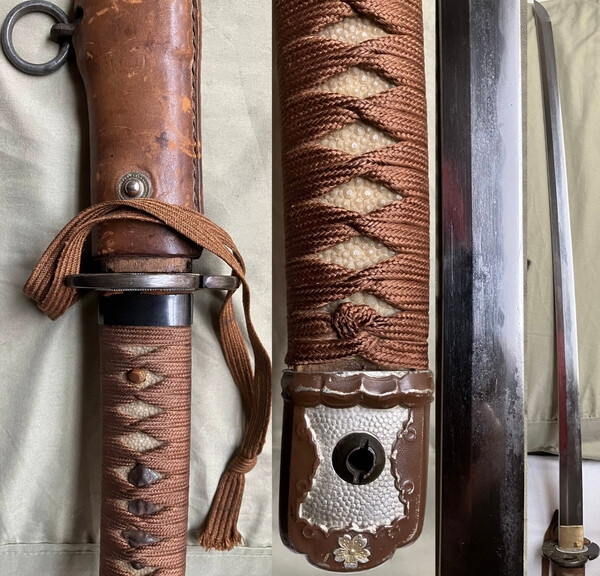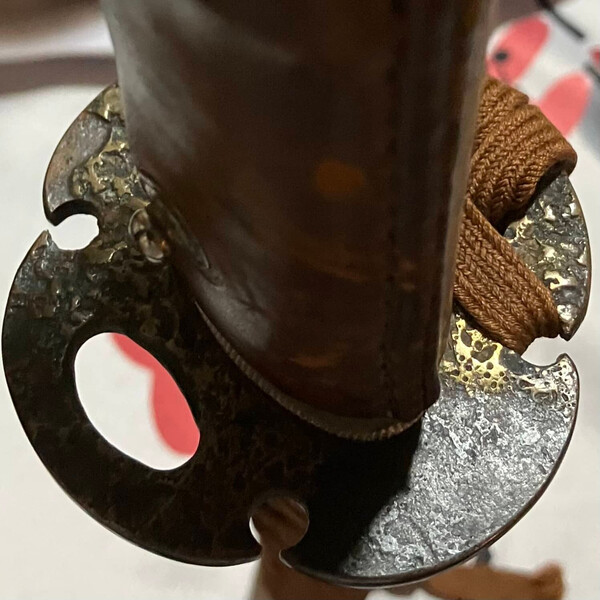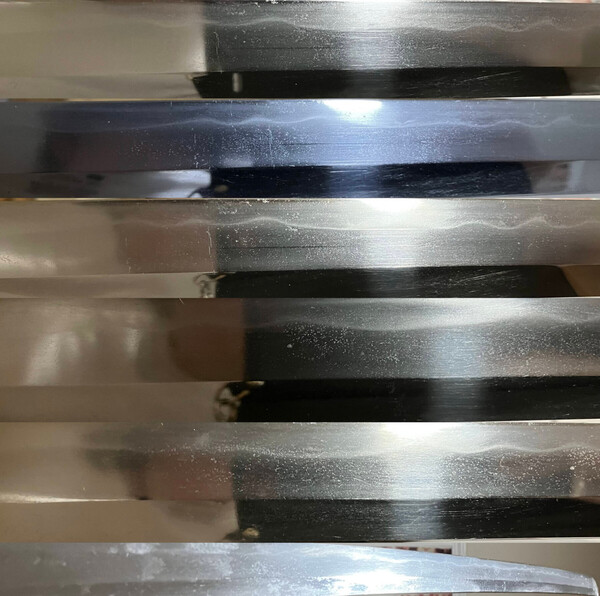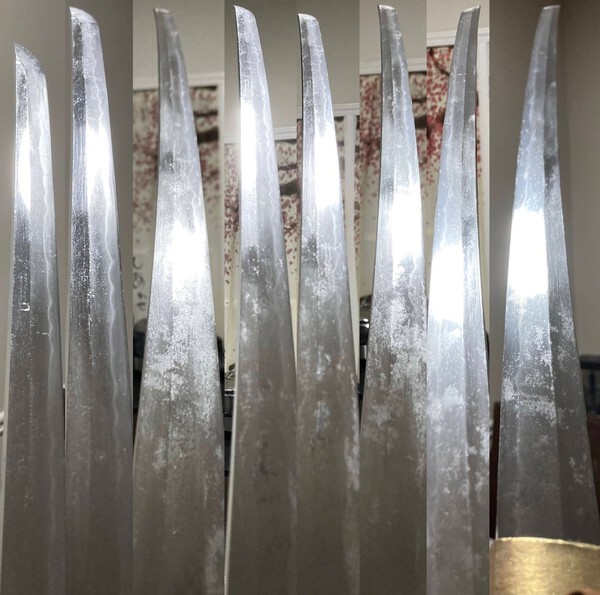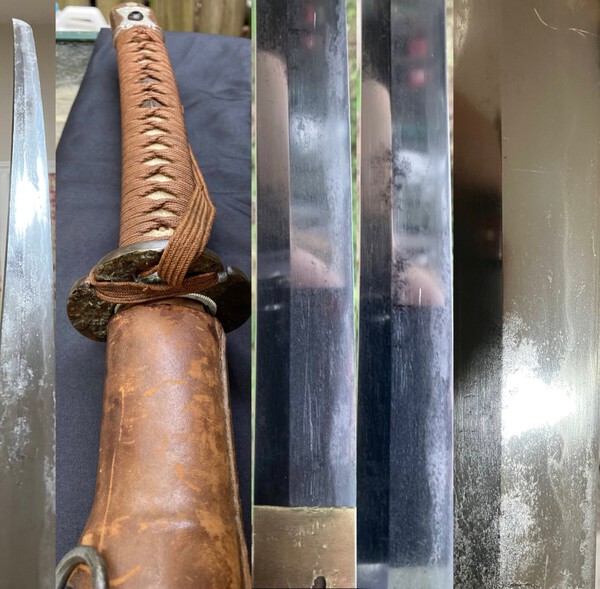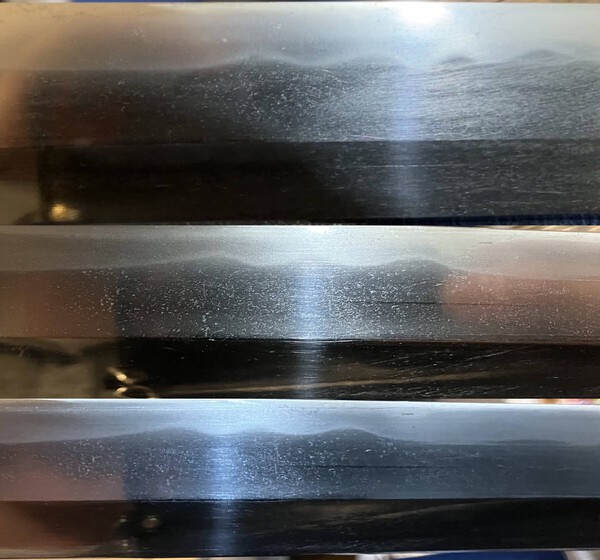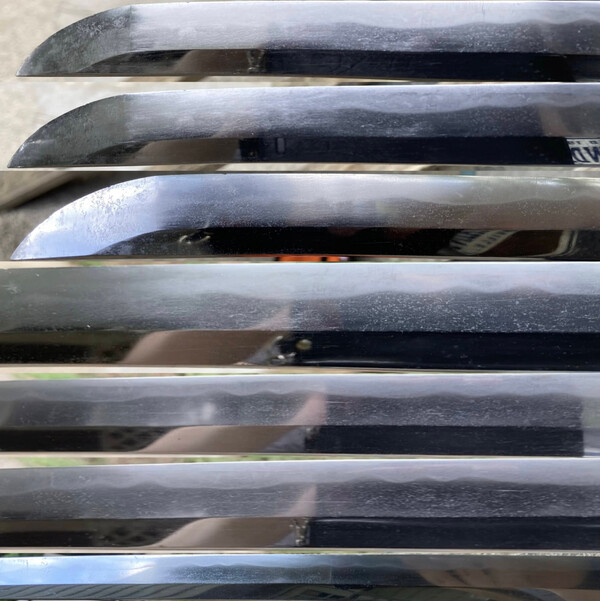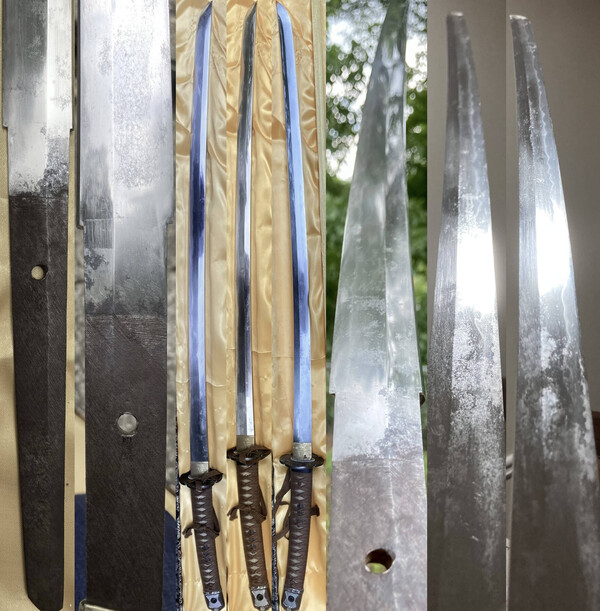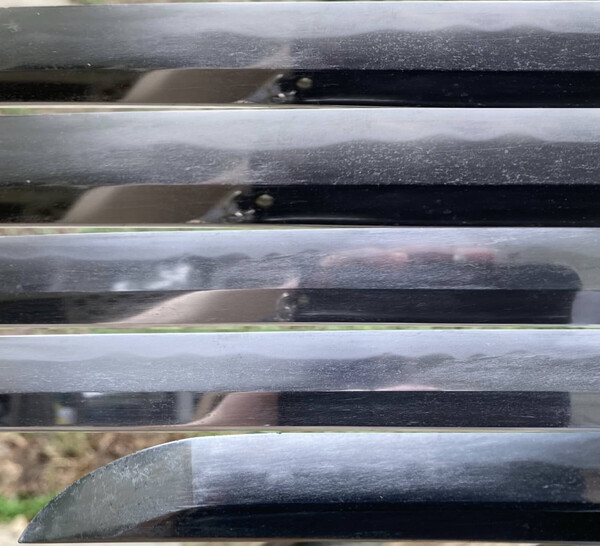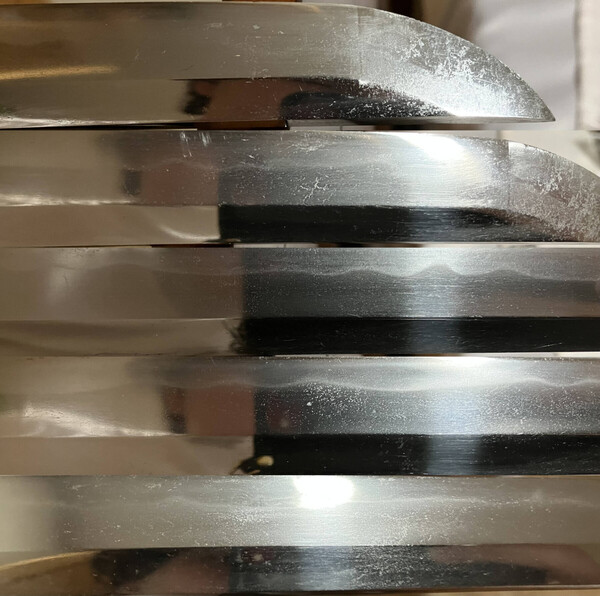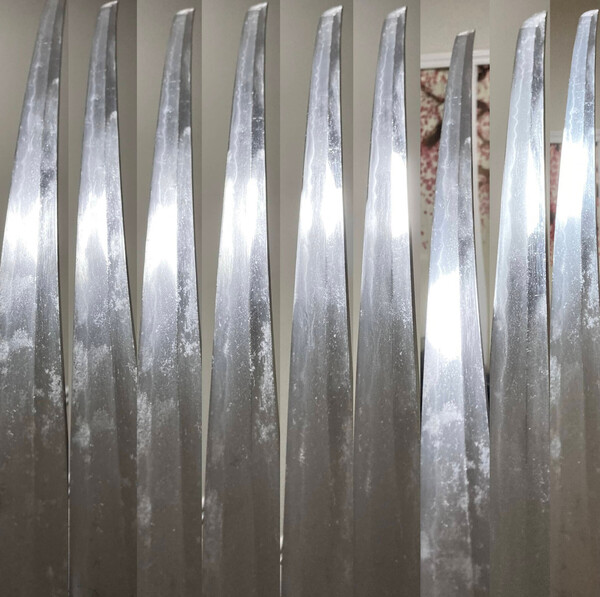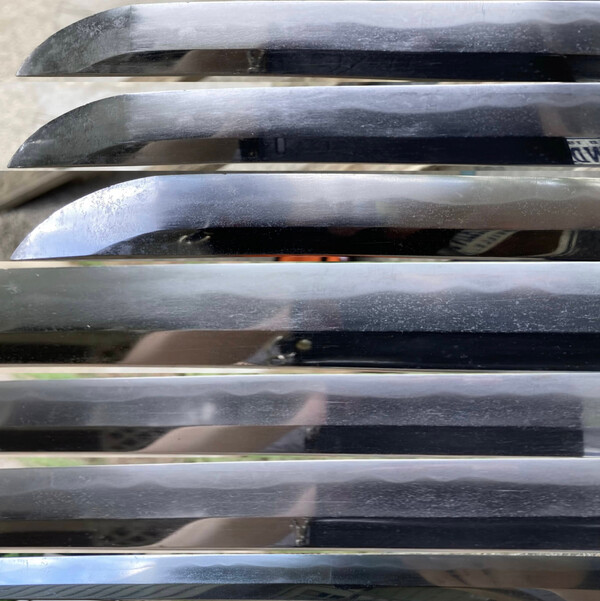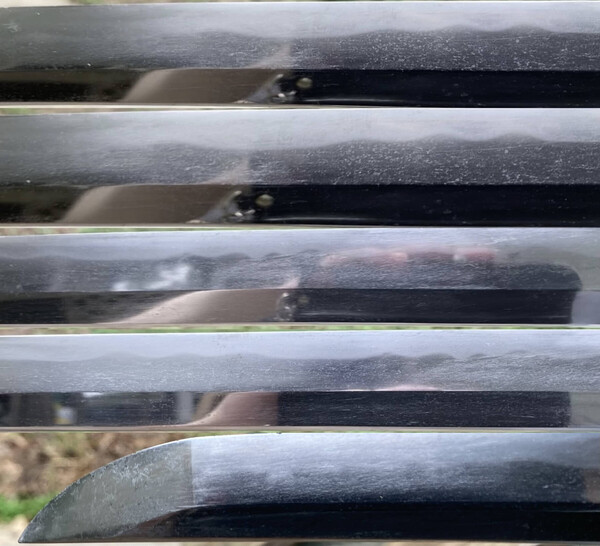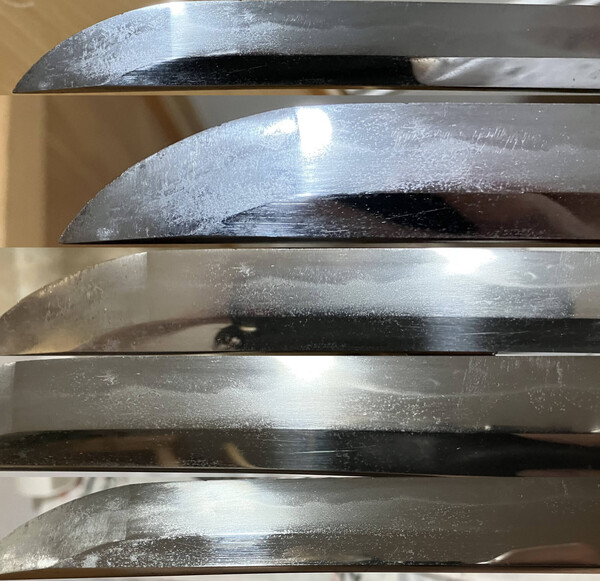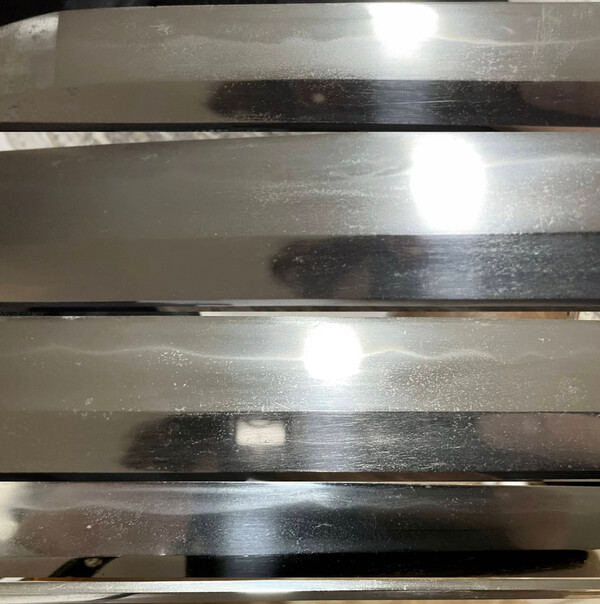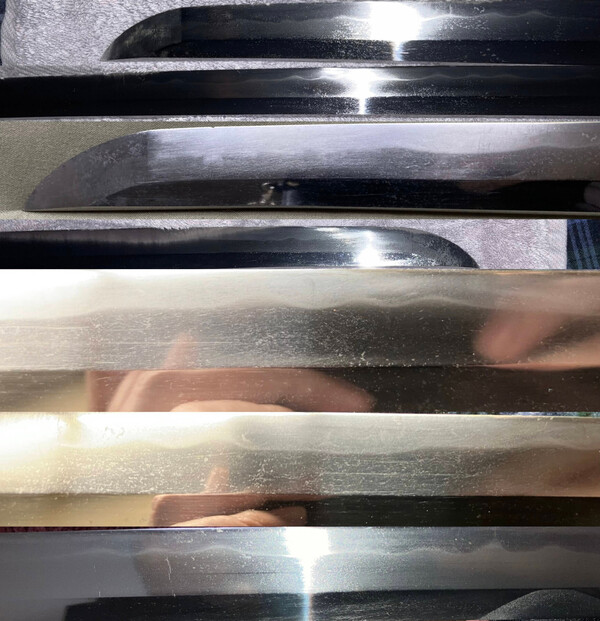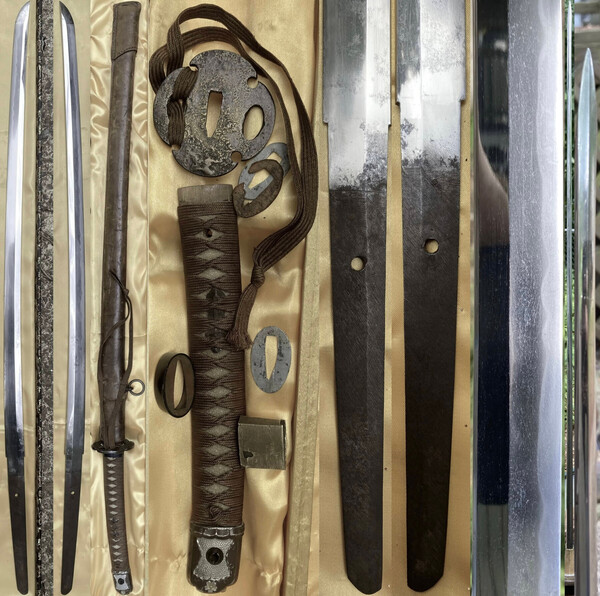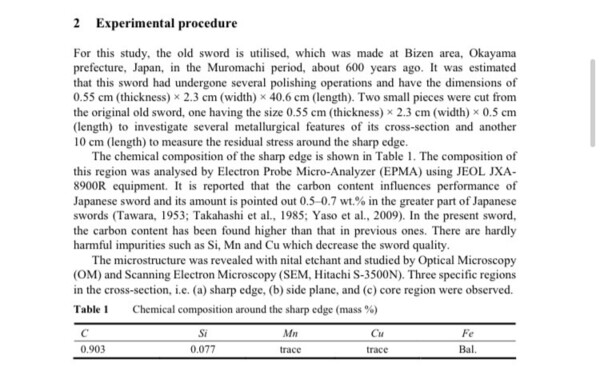-
Posts
253 -
Joined
-
Last visited
-
Days Won
1
Everything posted by AntiquarianCat
-
I still remember when I showed Mr. Benson that pre sengoku Bizen sword. The one with the nightmarishly bad horimono some bubba drilled in. Wasn’t worth a polish because of that but he tried to put a glass half full take on the news on it by saying at least “it’s good for martial arts”. I don’t know if he meant it seriously or not (probably just his way of softening the blow to a rookie) but I couldn’t bring myself to scuff my sword any further. Japan might use swords like that for martial arts but in America we can buy faithful replica and spare antiques so that future generations may still have them. I’m currently looking at Zsey, very well proportioned compared to most replica, even look good. That avoids the problem of many replica that are shaped or balanced wrong. If I ever go back to taking classes and need a shinken I will use a replica that comes close to cloning gendai and spare the nihonto. For me they’re just something to photograph and display.
-
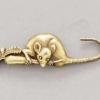
shin-shinto Curious about a Shinshinto with a lot of Tobiyaki/Muneyaki
AntiquarianCat replied to AntiquarianCat's topic in Nihonto
Very fitting that not paying enough attention to the Mino tradition meant I missed that. Thank you very much for that pointer, Chris. I’ll go and read up on Mino. See what the smith was trying to emulate. -

shin-shinto Curious about a Shinshinto with a lot of Tobiyaki/Muneyaki
AntiquarianCat replied to AntiquarianCat's topic in Nihonto
That would be interesting for sure. It looks like it could be done without harming other parts. I’m not quite brave, or practiced enough to try though. If I can make it to the sword show this one might tag along with the other converted civilian. That way more skilled eyes can handle it in person. -

shin-shinto Curious about a Shinshinto with a lot of Tobiyaki/Muneyaki
AntiquarianCat replied to AntiquarianCat's topic in Nihonto
Thanks for mentioning the Kabutogane John! I was actually wondering why this sword did not have officer indicators despite undergoing gunto conversion. I can’t find the example I saw in war relics but it’s mentioned there that due to a severe Type95 shortage they allowed NCOs to bring ancestral blades if they forfeited possession of a type 95. https://www.warrelics.eu/forum/Japanese-militaria/deflating-another-myth-type-3-army-officera-s-sword-expanded-version-584796/ I wonder if the converted civilian fittings and NCO part might show this one was used in place of a Type95? Throw on NCO fittings so that it wouldn’t seem like the wearer was dressing as an officer? Regarding the hardening, I did wonder if it was accidental but the small size of the nie throughout the sword, including the yaki patches made me wonder if there could have been a degree of intentionality. The other sword I saw with muneyaki -a clear example of an accident even to someone inexperienced in this like me- had random splotches of Ara-Nie on the hardened spots. Here the size seems oddly uniform. -

shin-shinto Curious about a Shinshinto with a lot of Tobiyaki/Muneyaki
AntiquarianCat replied to AntiquarianCat's topic in Nihonto
I forgot to mention, the hamon, particularly in the later half of the sword while not identical on both sides is quite similar: the gunome salvos for instance will happen at the same location with the peaks/valleys on both sides being located the same spot. -
This is only a guess so I hope you will forgive any mistakes but the Mihaba seems wide, especially for a swords that’s lost it’s hamachi. There is also terminal curvature. That makes me want to say it’s late muromachi or later https://www.google.com/amp/s/markussesko.com/2015/04/13/kantei-1-sugata-7/amp/
-

Is this some kind of repair job?
AntiquarianCat replied to Fuuten's topic in Auctions and Online Sales or Sellers
I’m not commenting on this sword but I’m curious about microwelding in general. Would they be using the new laser techniques that could weld say hagire while sparing the rest of the Hamon? So long as it’s well disclosed I wouldn’t see the harm in helping a fatally flawed sword regain some of its dignity. Of course if it was done for kitaeware or some other non ruinous flaw it’s obviously foolish, but I still think it could help blades with nothing to lose. -

shin-shinto Curious about a Shinshinto with a lot of Tobiyaki/Muneyaki
AntiquarianCat replied to AntiquarianCat's topic in Nihonto
Also I'm going to embed youtubes looking at the hardened spots. I think those show most what they look like: nie surrounded by white nioi type effect. -

shin-shinto Curious about a Shinshinto with a lot of Tobiyaki/Muneyaki
AntiquarianCat replied to AntiquarianCat's topic in Nihonto
-
Hello again, I'm still on a gunto detour and would appreciate any thoughts others have on this sword I grabbed from our forum and would especially value ideas regarding what schools it might be tied to: It's seems to be another civilian sword converted to gunto use, hence the simple haikan and leather cover combined with the a civilian tsuba and other parts. I'm quite sure the blade is Shinshinto as it is fairly large and has little taper or curvature, and the nakago is also large and has patina somewhere between the thin growth on gendai and thicker growth on a Shinto era. Also doesn't have masame on the shinogi like the modal shinto. The sword's proportions are a nagasa of 70.5cm, Motohaba of 3.1 and Sakihaba of 2.3, which also seem within the shinshinto norm. Like the nakago, the kisaki is also bigger than the kanbun examples I've held. The first thing that struck me is the fittings on this sword are pretty nice: gold foiled habaki, shakudo fuchi, old iron ken menuki and a tsuba that seems to be made of wrought iron with copper alloy inlays above, rim is silver-grey and some scratches on it look silver so might be shibuichi. Makes me think the owner was pretty fond of it. Second was of course that it was a shinshinto and seemed to have a lot of patches of hardened steel on the ji and mune, most of the blade is out of polish hindering study but the the monouchi more or less is in polish and from studying the hardened spots there I can see they're composed of very dense amounts of nie that are at also acompanied by nioi like white clouds, in fact, the clouds in the densest area (just before the kisaki) look a lot like an extension of the hamon. I hope the photos I took show what I mean. There are a lot of rust spots and scratches in the tsubamoto so please focus on the monouchi to see the tobiyaki/muneyaki I've been pouring over Markus Sesko's Shinshinto-shi and other reference books to try and get an idea of what school the smith might have been trained by but so far have no solid suspect(or at least not one I'm brave/convinced enough to stick my neck out for). Apart from the hardening other possible Kantei traits I can see are the yakidashi, the gunome midare hamon that does gunome in salvos of three, the boshi with marked turnback and some hakikake, and osujikai with kesho for the nakago. It's worth mentioning the hamon has konie (although because the poor polish they're easiest to see in the monouchi) and right before the kisaki there is a lot of terminal widening of the hamon. Given how much hardening exists outside the hamon I wonder if it would be right to call this Hitatsura? I'd be happy for any thoughts or a suggestion on which page to focus on in Shinshinto-shi. Thanks
-
It depends on what you want it for. There are many academic publications that have recipies for making rokusho type solutions http://shura.shu.ac.uk/971/ Obviously I’m not endorsing it’s use on antique items or the like but I’ve used the coper acetate, coper sulfide, vinegar and NaOH forumula to great effect on arts and crafts coper metalwork my friends have gifted me. Fair disclosure, it’s more a reverse engineer of rokusho than actual rokusho. The actual rokusho seems to be something Japanese artisans pass in a secretive way and would probably be hard for us to make using a lot of organic mater. Still, I’ve found it to work very well for my crafts and according to the papers the chemical substitute nearly replicates rokusho patina.
-

Info on this mumei bring back from WW2?
AntiquarianCat replied to jdawg221's topic in General Nihonto Related Discussion
I agree with the sengoku mino opinion. Late muromachi sugata with saki sori and a togari gunome hamon. A lot of mino swords were made too so it would be one of the more common blades to encounter. It reminds me of a sue-seki I once owned. Also it’s not a gunto. Civilian koshirae that was never converted to gunto use. In all honesty they seem newer to my eyes than the pre surrender showa examples I have. -

Second Generation Muramasa - Green Papers...???
AntiquarianCat replied to Infinite_Wisdumb's topic in Nihonto
I'm surprised green papers were so generous with attributions. It seems like almost everything with the mei and a passing resemblance got papered. This made me want to reread Darcy’s blog, it's always relevant https://web.archive.org/web/20210123052725/https://blog.yuhindo.com/green-papers-no-papers/ Also I’m surprised the auction ended at about 20K USD, I guess the temptation to have a sword and a piece of paper claiming it's a legendary sword was just too strong for some. -

Yuhindo.com is gone
AntiquarianCat replied to Katsujinken's topic in General Nihonto Related Discussion
I noticed it went down yesterday. I’m very sorry about his passing to both his family and the great loss to the community. I do hope his writings will eventually become accessible again. I can say I found the tips invaluable and they helped me avoid beginner mistakes such as misuse of uchiko. I would frequently link them to others or link the swords he had on his sale archives as representative of a school. The advice he provided and the detailed records of swords he took will be missed. -
Yes, that is indeed the Nossa Senhora da Graça battle you’re speaking off. As I mentioned Arima’s men had little dingies instead of ships and obviously no canons. There is no dispute that pirates and statelets (not counting a few like Date) lacked the organization to field ships and artillery. now battles between organized states (Ming Dutch wars and Imijin war between Ming and Hideyoshi) are a different beast and probably show what each party was capable of. I’ve heard that many Daimyo who lacked wealth would instead sell their own and for some reason the Iberian Jesuit accepted that trade. Which along with being defeated by the Dutch probably did much to get them removed from Japan. Regarding the Dutch and the Portuguese wars, they span the early 1600’s exactly the same time as the Nossa Senhora da Graça incident. And indeed the Dutch helped push Tokugawa into expelling Portugal. So yes, it is fair to link them with that larger conflict. My point is not that Iberians were bad fighters at all, it’s just that as you say organization and logistics were key. I would not be surprised if thanks to all its past conflicts Iberians were man for man the better swashbucklers but it didn’t matter as more supplies and organization meant the Dutch soundly defeated them(in the Far East). The same way wako lacked the organization and arms to sink warships the scattered Portuguese possessions in the Far East lacked the means to hold out. And I see the Ming easily defeating the Dutch as more evidence for that view: thanks to Confucius China was not a militaristic society and yet they easily beat the Dutch who had easily beat Portugal. Why? Much better logistics and organization(scattered colonies versus a regional superpower with near unlimited access to resources). Note that despite lacking sea power Toyotomi’s men almost won the Imijin war against the same Ming, why? Organization. Since Nobunaga they were well equipped and using pike and shot tactics oddly reminiscent of Maurice of Nassau. And why did Toyotomi lose? Logistic problems exacerbated by the Koreans and Chinese winning control of the sea.
-
Indeed, I would like it if Yaso added European blades to his next studies. The key takeaway point from those to what I want to say is note the very well controlled hardness of that bizen sword? Ha over 60hrc while the rest of the blade like the Ji is softer and more elastic? Well, low carbon on the core and where the utsuri happens seems to be a very deliberate thing. If you just had a uniformly hard sword like some late Shinto that massahide complained about it’s more likely to break. So Japanese swords having mild steel is part of their break resistance not a bug. Perhaps the European swords on the hardness “study” (as I said the poor condition of swords might have compromised study) I linked could be high carbon because on a balance they never get near as hard but if you fully hardened a big stick of all 1.0% carbon you’d get brittle. So limiting hard to the edge and supporting it with a soft spine makes sense. I would like it if they could look at older Toledo swords but my understanding is the non edged parts being milder was a long running feature of that tradition too and gave them shock resistance. As for age of discovery wars and their relevance in weapons use, I have heard of the Wako-European battles https://en.m.wikipedia.org/wiki/Nossa_Senhora_da_Graça_incident seems to be typical. The reason wako and Arima’s men had trouble on a Carack is not that a Japanese sword is bad for swashbuckling. It’s that a little dinghy isn’t good for boarding a big ship. In this case laking a galleon of your own and canons probably is the deficiency. Case in point the Dutch eventually defeated Portugal and took most of their eastern possessions (so they can’t be weak) but were then themselves thoroughly defeated by the Ming Chinese https://en.m.wikipedia.org/wiki/Sino-Dutch_conflicts Why? It’s probably not that Dutch arms were better than their Portuguese equivalents or that the Chinese jian was spectacular compared to Dutch side swords. Instead just boils down to the side with more organization guns and resources. That said both the Yuan dynasty and the Ming chronicles of their Imijin war single out the Japanese sword for respect. So if the guys who clobbered the Dutch who clobbered the Portuguese think it’s a scary sword to get cut by I’d listen to them. There is indeed a type of sword associated with Japanese pirates and swashbucklers. They’re Kaifu swords https://to-ken.uk/onewebmedia/Kaifu 19 05 2016v1.pdf very distinctive although they were around long before Europeans arrived.
-

Requesting info and ID on unknown signed wakizashi
AntiquarianCat replied to Kiita's topic in Nihonto
The shape (Saki-sori + Wide mihaba) looks Muromachi to my eyes. -
I would refer you to the many studies done by M. Yaso, because he had access to modern xray technology it is possible to get a very accurate elemental composition without destroying a sword. https://www.semanticscholar.org/paper/Study-of-strength-and-toughness-in-Japanese-sword-Yaso-Takaiwa/f75e6d7a92043c923999763505fdbc726329cc26 A free version can be found here [International Journal of Materials and Product Technology vol. 42 iss. 1_2] Yaso, M._ Takaiwa, T._ Minagi, Y._ Kanaizumi, T._ Kubota, K._ No - Study of strength and toughness in Japanese sword produced from Tamahagane steel by - libgen.li.pdf Remarkably enough Yaso found their smiths did such a good job at stamping away impurities that it holds up well even by modern standards. That the spine and ji have milder steel is probably intended for flexibility as one of the likely ways they made utsuri required mild steel and that certainly made them more resilient to breakage. Probably important given the high 50s to mid 60s hrc yaso and others found for edge hardness. As for western swords the carbon content might not be especially relevant. I hope you will forgive this non peer reviewed source but study of western swords shows an edge hardness often below 50HRC so I don’t know what the point of mentioning a high carbon content everywhere is; it is possible because as you mentioned Europe was careless in preserving its swords surface and so most medieval have extensive damage to edge that that study is skewed by the harder layers being lost or mineralized but at the least it shows there isn’t much apparent effect from a uniformly high C. This is in no way to say Europe did not have equally fantastic blades, just that the science doesn’t support most of these metallurgy claims. By the way some of the best regarded European traditions like Toledo developed an oddly similar knack for having milder steel in the core of their swords https://www.researchgate.net/publication/328748284_Welding_by_Hot_Forging_of_Two_Carbon_Steels_for_the_Manufacture_of_Spanish_and_Japanese_Weapons There are interesting parallels. Perhaps some kind of convergent evolution? And regarding polishing being aggressive. My understanding is that if the blade condition is good little more than a finishing polish is needed. Which might remove a few microns of steel. Case in point many treasure swords and temple swords are virtually unchanged from when they were made. Deeper polish is only done when there is a serious problem like rust and even then they try to limit what’s removed. Preventing rust has served to preserve blades and their surface. You have to remember even black rust “patina” is not stable on a generational timescale. Still going to chemically grow and turn useful edge and surface into encrustations, and mineralization obliterates whatever nice metallurgical effects we would want to admire or study. The problem is so serious that the late Darcy endorsed oiling nakago to arrest mineralization. I can only imagine how unfortunate it would be for the sword and any study thereof if we let the edge surface mineralize away. https://blog.yuhindo.com/oil-your-nakago/?sfw=pass1651334746
-
I still found it quite useful as a how to spot sue-bizen from photos refresher.
-
I’m fond of the fedex idea but I’m not sure if there is a way for me to safely send multiple swords in one package. Or if I will just have to send each and everyone in a separate box. The plan was to take one katana, one wakizashi and two tanto to the show. Obviously the swords safety is the top priority but since numerous fedex boxes can get pricey I’d like to know if there is any safe way to consolidate them to say two shipments rather than four.
-

Is this a real nihonto or a scam?
AntiquarianCat replied to jdawg221's topic in Auctions and Online Sales or Sellers
I’m pretty sure this is one of Changtian Sword’s new eBay accounts. This stuff looks spot on for his usual replica. Thanks for letting people know. -
I hope this was posted in the right section but I plan to be in the San Francisco sword show and plan on taking a locked case of swords to the shinsa. I’m worried the case could get stolen by a thief. I’ve heard of many cases where checked baggage gets stolen. What can be done to dissuade that and would the insurance airlines offer do anything to lessen the likelihood of a loss? I’ve noticed if I insure a USPS package they’re far less likely to lose it. Maybe something like that could apply here? Also does anyone know how viable Apple Tags are as an anti theft tool? Thanks,
-
I guess my reason for guessing Bizen Kiyomitsu is it looks sue-Bizen, has suguha and coarseish hada, so B. Kiyomitsu is as good a gamble as any.
-
It might be worth mentioning there are many documented cases where people have lost old and desirable blades because of leaving them in the hands of a polisher without formal training. I’ll admit I don’t know much about polishing but my understanding is a classically trained polisher will seldom be “very agressive and take out metal” especially if the overall geometry is intact like yours. The reason is a sword’s lifespan is measured in metal and once you run out of hard outer steel the sword is effectively dead. That’s why trained polishers always endeavor to remove as little metal as possible.




